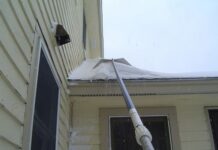By Melissa Kossler Dutton
BOSTON —
It took Brian Koehl about a year to buy the materials to build a backyard greenhouse.
Koehl, a master gardener from Waller, Texas, bought secondhand windows and doors to construct the building that houses his roses and vegetables. Using old materials saved him money, and added interest to the structure.
“I really liked the look of using old windows,” he said. “It met all of my needs.”
Many homeowners these days are considering using secondhand items for home-improvement projects.
“The interest keeps growing,” said Justin Green, program director for Build It Green NYC, in New York City. “The No. 1 driver is you can save a lot of money. The No. 2 is people are interested in being green.”
Used building supplies can cost 50 percent to 90 percent less than new, said Shane Endicott, executive director of the Rebuilding Center in Portland, Ore.
“It’s a huge motivator for people to reuse,” he said.
Lots of large cities, including Seattle, Los Angeles and Austin, Texas, now have stores that sell used building materials, such as lumber, kitchen cabinets, lighting fixtures and sinks. Many of the stores are operated by Habitat for Humanity, which sells donated goods to raise money to build houses (using new materials) for low-income families.
Some of the resale shops also operate deconstruction businesses that tear down old buildings to salvage as much material as possible.
“Our goal is to be competitive with the wrecking ball,” said Tom Longstreth, executive director of ReSOURCE, a nonprofit that offers deconstruction services and sells used building materials in Burlington, Vt. “It really is a win-win. There’s a huge volume we are able to keep out of landfills.”
Karen and Bradford “Skip” Hardy routinely find quality materials they could not normally afford at ReSOURCE. Past purchases have included bathroom faucets and windows.
“We seem to get lucky. We get there at the right time,” Bradford Hardy said. “On a bad year, we probably spend $2,000 there. In a good year, we spend $8,000 to $10,000.”
The store also allows the couple to indulge their creative sides. He recently found large wooden pipes from an old organ, and intends to use them for giant garden wind chimes. She has turned old tile pieces into coasters.
Pam Kueber of Retrorenovation.com hears from lots of secondhand-goods shoppers who have found creative uses for old building materials and household products.
“This is something you do out of joy and creativity as much as utility and frugality,” said Kueber, who lives in a 1951 Colonial-ranch house in Lenox.
The growth in the number of stores around the country has made it possible for more people to consider used materials, she said. In the past, she added, it was mostly people restoring old homes and looking for items from a specific era who were drawn to used items.
Bart Niswonger has shopped at the ReStore Home Improvement Center in Springfield, for period pieces and bargains. “We’ve bought a whole bunch of stuff from them,” said Niswonger of Worthington.
He has purchased light fixtures, sinks and doors, including some items for a 1920s house he restored. A furniture maker, he also used items from the store while creating his workshop.
During the restoration project, Niswonger and his wife, Eliza, spotted wood from an old bowling alley at the store. He turned pieces of the old bowling lanes into kitchen countertops.
“It was interesting material,” he said. “We liked the history of it.”
Knowing something about the materials you use makes a difference, agreed Koehl. He was excited to learn that some of the windows he used in his greenhouse came from the Peach Tree Bed and Breakfast in Fredericksburg, Texas.
“That sold me more than anything else,” he recalled. “I love to have a story.” — AP












